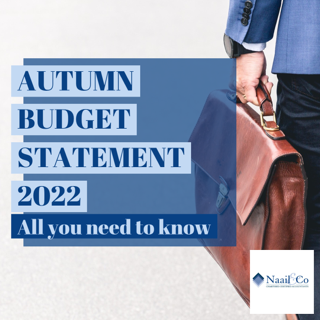Autumn Budget statement 2022
All you need to know
Table of Contents
The Autumn Statement 2022 from Chancellor Jeremy Hunt aimed to maintain public service funding, protect economic development and restore stability. We have broken down announcements from the Autumn Statement 2022 into various sections so you can find out what this budget means for you?
KEY POINTS
– Tax free personal allowance: Frozen until April 2028, effecting 30 million taxpayers to pay higher tax
– Basic & higher rate thresholds: Frozen until April 2028, pushing people into higher rate tax band
– Top rate (45%) income tax threshold: Reduced from £150,000 to £125,140 effecting 250,000 taxpayers
– Dividend tax allowance: Reduced by half from £2,000 to £1,000 and then to £500 in subsequent year
– Capital Gains Tax exemption: Cut from £12,300 to £6,000 and then to £3,000 in subsequent year
– Minimum wage: Raised from £9.50 to £10.42 per hour, an increase of over £1,600 per annum
– Inheritance Tax threshold: Frozen until 2028
– Stamp Duty: Current thresholds (No duty on £250k & £425k for 1st time buyer) to stay until 2025
– State Pension: 10.1% increase as triple lock guaranteed for 2023/24
– R&D tax relief: RDEC rate increased from 13% to 20% and SME rate decreased from 14.5% to 10%
– Business Rates: Business rates multipliers frozen and percentage caps on annual increase
– Electric cars: Road tax exemption removed and P11d rates increased
– Diverted profits tax: Increased from 25% to 31%
– Windfall tax: Energy profits levy increased from 25% to 35%. New 45% tax for energy generators
– Global tax rate: Minimum 15% rate goes ahead
– Energy support package: Major changes
– Cost of living payments: Further one-off payments amounting to £1,350
– Mortgage support: Extended
Tax free personal allowance
The current tax-free Personal Allowance of £12,570 will be frozen until April 2028 – a further two-year extension to the freeze which was previously expected to end in 2026. A classic example of stealth tax, where tax in collected without increasing the tax rates. Freezing of personal allowance threshold means those receiving a wage rise will pay more tax as the tax-free allowance will not increase accordingly.
Around 30 million people will be affected adversely with this announcement.
Basic & higher rate thresholds
The thresholds for 20% basic rate and 40% higher rate will be frozen until April 2028, dragging more people into higher rates of tax. Also, this announcement may push non-taxpayers into the basic rate tax bracket, including some two million more pensioners who will benefit from the state pension triple lock increase this year.
Around 750,000 people could be pushed into a higher rate tax band from April 2023 as a result of pay rises and a freeze on income tax thresholds.
Top rate (45%) income tax threshold
The Autumn Statement reduces the income tax additional rate threshold from £150,000 to £125,140, increasing taxes for those on high incomes from 6 April 2023. This announcement will pull more top earners into the 45p tax bracket.
So, any individual already paying the 45% rate in 2022/23 will face an income tax increase of at least £1,243 for 2023/24. Individuals with income of more than £100,000 will continue to have their Personal Allowance tapered, with those on incomes of more than £125,140, not being entitled to any Personal Allowance. Around 250,000 more people will be paying the top rate of tax and the threshold change will raise £420m in 2023-24, rising to £790m in 2024-25.
Chancellor Jeremy Hunt said: “We have tried to be fair by following two broad principles, by asking those with more to pay more. I have not raised headline rates of tax”
Dividend Income
The dividend tax allowance will be reduced by half, from £2,000 to £1,000, starting in April 2023, with further cuts to follow. From April 2024, the dividend allowance will be cut in half, to £500. The dividend allowance, which was first introduced in April 2016 and was originally worth £5,000 but was lowered to £2,000 starting in April 2018, would gradually lose value if it is further reduced.
By 2024–2025, this action is anticipated to raise £450 million, followed by £810 million in 2025–2026, with a projected cumulative impact of £3 billion by 2028.
Taxpayers with dividend income have also been impacted by the change to dividend tax rates from April 2022, which increased by 1.25% to deter taxpayers from using dividends to avoid the increased National Insurance rates and anticipated Health and Social Care Levy. Although this was abolished for employers and employees, the rise remains in place for dividends.
Capital Gain Tax exemption
The tax-free Capital Gains Annual Exemption will be reduced from £12,300 to £6,000 from 6 April 2023 and further reduced to £3,000 from 6 April 2024. However, despite speculation before the Autumn Statement, the rates of Capital Gains Tax payable on gains above the Annual Exemption amount remain unchanged at 10% to 28% (depending on the individual’s level of income and the type of asset sold). The CGT proceeds reporting limit will be fixed at £50,000.
This will increase the CGT liabilities of affected individuals by up to £1,764 and £2,604 in 2023/24 and 2024/25, respectively.
The measure is expected to raise £420m in 2024-25, rising to £855m by 2027-28. This measure is expected to raise £1.6bn over the next five years.
When you sell or otherwise dispose of assets, such as personal belongings, a second house, or shares that aren’t included in an ISA, capital gains tax is levied on any “gain” or profit you make.
Minimum wage
From April 2023, those on minimum wage aged 23 and over will see an increase by 9.7% from £9.50 to 10.42 an hour.
This represents an increase of over £1,600 to the annual earnings of a full-time worker and is expected to benefit over 2 million low paid workers.
From 1 April 2023, the national minimum wage paid to:
- Workers aged 23 and over will rise from £9.50 an hour to £10.42 an hour – a £1,600 a year, rise for full time workers.
- Workers aged 21 to 22 will rise from £9.18 an hour to £10.18 an hour.
- Workers aged 18 to 20 will rise from £6.83 an hour to £7.49 an hour.
- Workers aged 17 and under – and apprentices – will rise from £4.81an hour to £5.28 an hour.
Inheritance Tax threshold
Inheritance tax is payable on any estate above £325,000 – the tax rate is currently 40%. There is also the ‘residence nil-rate band’, which increases the tax-free allowance to £500,000 when the family home is passed to children/grandchildren. Both of these thresholds have been frozen until 2028.
Stamp Duty
In September, the Government raised the threshold at which homebuyers start paying stamp duty from £125,000 to £250,000. In addition, it increased the threshold at which first-time buyers start paying stamp duty from £300,000 to £425,000.
But today, Mr Hunt announced that both these changes would be reversed – though this won’t take effect until 2025. It means that from 2025, homebuyers won’t pay stamp duty on the first £125,000 of a main residential purchase, while first-time buyers won’t pay stamp duty on the first £300,000 of a main residential purchase.
State Pension
Since 2010, state pension hikes have been based on the so-called “triple lock” agreement, which ensures that benefits would increase in accordance with the larger of either September’s Consumer Prices Index (CPI) measure of inflation, average wage growth, or 2.5%.
Due to an increase in average earnings growth brought on by workers returning from furlough and the lifting of pandemic-related limitations, the triple lock was halted this fiscal year, and the increase was replaced by the “double lock,” which is based on the higher of 2.5% inflation or CPI.
The government announced today that the triple lock would be reinstated for both new and basic state pensions, resulting in a 10.1% increase.
R&D Tax reliefs
For expenditure on or after 1 April 2023:
- Research and Development Expenditure Credit (RDEC) rate will increase from 13% to 20%
- Small and Medium-sized Enterprises (SME) additional deduction will decrease from 130% to 86%
- SME credit rate will decrease from 14.5% to 10%.
The Chancellor announced that public spending on R&D tax credits will be increased, reaching £20bn annually by 2024-25. These Autumn Statement 2022 rate changes will be legislated for in the Autumn Finance Bill 2022.
Business Rates
Chancellor Jeremy Hunt has today set out additional support for the business rates sector within the Autumn Budget. With the confirmation that the 2023 Rating revaluation will go ahead as planned, the Chancellor confirmed two thirds of properties will see no increase to their bills next year.
From 1 April 2023, rateable values of non-domestic properties in England will be updated to reflect the property market at 1 April 2021. A set of reliefs including a freezing of business rates multipliers and percentage caps on annual increases in business rates will be introduced to mitigate the effect of the new valuations on ratepayers subject to substantial increases in bills.
The percentage increase in business rates bills as a result of the revaluation will also be subject to annual caps until 2025/2026 based on the rateable value:
Rateable Value | 2023/2024 | 2024/2025 | 2025/2026 |
£0 – £20,000/£28,000 in London | 5% | 10% | 25% |
£20,000/£28,000 – £100,000 | 15% | 25% | 40% |
£100,000 | 30% | 40% | 55% |
The proposed caps for 2024/2025 and 2025/2026 will be adjusted by the rate of inflationary increase to the business rate multipliers in due course.
Business rates reliefs for the retail, hospitality and leisure sectors introduced during the pandemic will be extended and increased by 25%.
Following consultation on prospective reforms to business rates, the Government has decided not to introduce an online sales tax.
Electric cars
The Government says it’ll start charging Vehicle Excise Duty (commonly known as road tax or car tax) on fully electric cars, vans and motorcycles from April 2025. These vehicles are currently exempt from the tax.
An EV is currently taxed as a benefit in kind (BIK) when made available for private use by an employer for an employee with a cash equivalent of 2% of the list price, and the government committed to retaining this rate until April 2025.
Nevertheless, in the Autumn Statement, it was announced that the BIK rate will increase to 3% for the 2025-26 tax year, 4% for 2026-27 and 5% for 2027-28. Similarly, all non EVs will also see the same 1% increase per annum over the same timescale.
This change has been anticipated by the Fleet industry and they, along with employers, will be pleased that we have certainty for next 4 years. Despite the increases announced, EVs are still a very attractive proposition for both employee and employer alike
Diverted profits tax
The rate of diverted profits tax will rise by 6% from the new tax year, according to the Autumn Statement Green Book
From April 2023, the rate of diverted profits tax will increase from 25% to 31%, in order to retain a 6% points differential above the main rate of corporation tax, and therefore ensure that it remains an effective deterrent against diverting profits out of the UK.
Windfall taxes
In the Autumn Statement, Chancellor Jeremy Hunt outlined a number of changes to the energy profit levy, alongside a new and temporary tax on electricity generators
From 1 January 2023, the rate of the energy profits levy will be increased to 35% from 25% to ensure oil and gas companies benefiting from increased profits will pay more in tax.
In addition to this, a new and temporary tax of 45% will be charged on the profits of electricity generators which, like the oil and gas sector, have seen profits increase.
The energy profits levy will see an overall rise in payments from 65% to 75% on profits from UK operations. This will last until March 2028, extended from the previous end date of December 2025.
Global tax rate
The government has confirmed that it will introduce the global minimum corporate tax rate for multinationals from 2024.
The 15% minimum tax rate on multinationals is known as the OECD Pillar 2 rules and they will come into force for accounting periods beginning on or after 31 December 2023.
‘This will protect the UK tax base against aggressive tax planning and reinforce the competitiveness of the UK, raising £2.3bn a year by 2027-28,’ the Treasury said.
Following consultation, the government will legislate to implement the globally agreed G20-OECD Inclusive Framework Pillar 2 in the UK.
Energy support package
The Energy Price Guarantee (EPG), implemented in October to shield homeowners from a horrifying 80% increase in energy costs, will continue after April, according to Chancellor Jeremy Hunt’s announcement today. However, the amount of support will be drastically reduced. A typical dual-fuel home currently pays £2,500 per year under the EPG; starting in April, that amount will increase to £3,000 per year until the end of March 2024.
- The energy price guarantee will be extended by another year from April, but rising from £2,500/year to £3,000/year for a typical home (use more, and you’ll pay more)
- The alternative fuel payment will be doubled (for those on heating oil, LPG and similar) increasing from £100 to £200 this winter
- A one-off payment of £900 for those on certain means-tested benefits next year
- A one-off £300 payment for pensioners next year
- A one-off £150 payment for those on certain non-means-tested disability benefits next year
- The Household Support Fund will be extended by another year
- A Consultation on the future of the EPG, including whether it should be based on volumetric rates
Cost of living payments
These will be distributed throughout the UK and are in addition to the current cost of living payments made this year. You could receive one, two, three, or all of the payments, up to a maximum of £1,350, depending on your specific situation. They won’t be subject to taxes, won’t count toward the benefit cap, and won’t affect current benefit awards.
The specifics and timing of how the payments would be made, however, have not yet been determined. Here is what we currently know:
- An extra £900 for those on means-tested benefits
- An extra £300 for pensioners
- An extra £150 for those on disability benefits
Mortgage support
The government has stated that more homeowners who are having trouble making their mortgage payments would be eligible for assistance next year. From spring 2023, access to the ‘support for mortgage interest’ “SMI” scheme will be expanded – meaning you might be able to get help covering the interest element of your mortgage repayments if you’re struggling.
- SMI can help with the interest on the first £200,000 of your mortgage balance
- SMI won’t necessarily cover all of the interest you need to pay
- SMI is paid as a loan – meaning whatever you borrow you’ll need to repay
To qualify for SMI, you usually need to be earning one of a number of qualifying benefits, such as universal credit or pension credit. The list also includes income support, income-based jobseeker’s allowance and income-related employment support allowance, but these legacy benefits are no longer open to new applicants.

Our service to you
If you are a self employed, business owner/director of company looking to get your accountancy and taxation matters sorted, look no further. We, at Naail & Co, are pro-active and easily accessible accountants and tax advisors, who will not only ensure that all your filing obligations are up to date with Companies House and HMRC, but also you do not pay a penny more in taxes than you have to. We work on a fixed fee basis and provide same day response to all your phone and email enquiries. We will also allocate a designated accounts manager who would have better understanding of your and business financial and taxation affairs. Book a free consultation call using the link below.
Related pages:
Get further information from the following pages;
Related Blogs:
Get further information from the following blogs;
Subscribe to our newsletter
BUSINESS HOURS
Monday – Friday
- 9:00 am – 5:30 pm
Pages:
Menu








